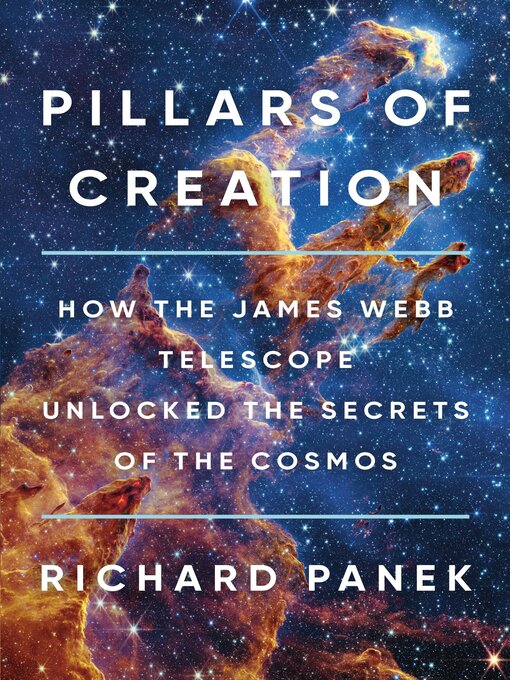Pillars of Creation
How the James Webb Telescope Unlocked the Secrets of the Cosmos
Pillars of Creation tells the story of one of the greatest scientific achievements in the history of civilization, a $10 billion instrument with a staggeringly ambitious goal: unlocking the secrets of the cosmos. Award-winning science writer Richard Panek stands us shoulder to shoulder with senior scientists as they conceive the mission, meet decades-long challenges to bring it to fruition, and, now, use its unprecedented technology to yield new discoveries about the origins of our solar system, to search for life on planets around other suns, and to trace the growth of hundreds of billions of galaxies all the way back to the birth of the first stars. The Webb telescope has captured the world’s imagination, and Pillars of Creation shows how and why—including through sixteen pages of awe-inspiring, full-color photos.
At once a testament to human ingenuity and a celebration of mankind’s biggest leap yet into the cosmos, Panek’s eye-opening book reveals our universe as we’ve never seen it before—through the lens of the James Webb Space Telescope, a marvel that is itself a pillar of creation.
-
Creators
-
Publisher
-
Release date
October 22, 2024 -
Formats
-
Kindle Book
-
OverDrive Read
- ISBN: 9780316570718
-
EPUB ebook
- ISBN: 9780316570718
- File size: 30554 KB
-
-
Languages
- English
-
Reviews
-
Kirkus
Starred review from September 15, 2024
Accessible account of how the Webb telescope has revolutionized the field of astronomy. Panek is highly respected as a science writer who won the American Institute of Physics communication award forThe 4% Universe: Dark Matter, Dark Energy, and the Race to Discover the Rest of Reality. InPillars of Creation--the title refers to twin towers of gas and dust in a nebulous cloud 41 trillion miles from Earth--he continues the theme, focusing on the James Webb Space Telescope, launched in 2021 as a successor to the long-serving Hubble Telescope. The whole project almost failed to get off the ground, as Panek explains in the first section here. There were huge technical issues about the equipment that Webb would carry, and the delays and budget blowouts were so great that Congress nearly shelved the entire undertaking. But somehow the problems were overcome, and the first spectroscopic images were sent back in February 2022. Much of the information received from Webb has led to a fundamental rethinking of astronomical models, especially the possible age of the universe. There have even been hints of life on distant exoplanets and unexpected clues about the composition of galaxies and cosmic dust. Panek tells the story with infectious enthusiasm and looks ahead in an epilogue to the next step in astronomical exploration, the Habitable Worlds Observatory, which is planned for deployment in the early 2040s.Sixteen pages of remarkable photographs, including some of nearby planets, are a bonus in this enjoyable text. Webb's images are available for download from the Barbara A. Mikulski Archive for Space Telescopes, named for the former senator who saved the project. An essential read for anyone interested in the new frontiers of science, written with clarity and authority.COPYRIGHT(2024) Kirkus Reviews, ALL RIGHTS RESERVED.
-
Publisher's Weekly
Starred review from August 12, 2024
In this stellar account, science writer Panek (The Trouble with Gravity) details the James Webb Space Telescope’s journey from conception to outer space. He explains how astrophysicist Riccardo Giacconi began planning the Webb as a successor to the Hubble Space Telescope as early as five years before Hubble’s 1990 launch, as well as how NASA had to battle Congress for continued funding as the project ran over budget by billions of dollars and delays pushed back the launch date by over a decade. (Webb finally reached space in 2021.) Conveying the amazing ingenuity involved in constructing the telescope, Panek describes how keeping the heat-sensitive infrared telescope near absolute zero (−459.67ºF) required engineers to devise a sunshield composed of five layers, each thinner than one-thirtieth the width of a human hair, that cumulatively provide SPF (“as in sunscreen lotions”) one million. Panek captures tense scenes in mission control as engineers dealt with such challenges as faulty sunshield mechanisms and collisions with micrometeoroids, and he offers a wondrous overview of Webb’s major breakthroughs, noting, for instance, that its discovery of water in the asteroid belt has forced astronomers to consider that the habitable zone for life might be larger than previously thought. Brimming with the excitement of scientific discovery, this soars. Agent: David Granger, Aevitas Creative Management.
-
Loading
Why is availability limited?
×Availability can change throughout the month based on the library's budget. You can still place a hold on the title, and your hold will be automatically filled as soon as the title is available again.
The Kindle Book format for this title is not supported on:
×Read-along ebook
×The OverDrive Read format of this ebook has professional narration that plays while you read in your browser. Learn more here.


